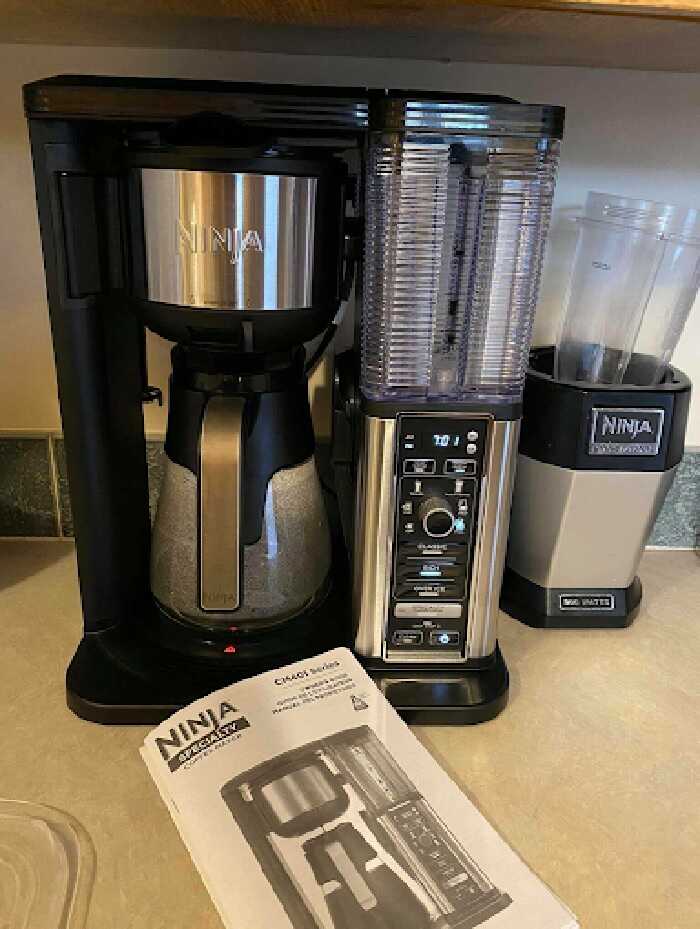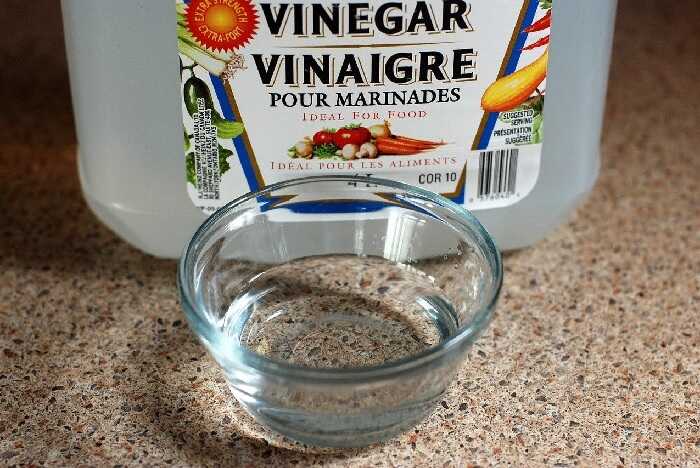Before getting insight into the main topic of how to clean the Ninja coffee maker, do you know why you need to read and save the guide?
I know many people who rarely clean their coffee makers, thinking that assembling parts might cause the machine to work improperly. Some devote their trust to the self-cleaning mode advertised by the manufacturers.
Periodic cleaning is recommended to ensure the best coffee taste and make the most out of the machine’s lifespan.
Contents
An Overview of Ninja Coffee Makers

How long have you used Ninja coffee makers, and are they working perfectly so far?
From my experience with the Ninja CM401, this brand is well-worth buying. Most of their home appliances – in general, and coffee makers, in particular, are compact, sturdy, and sleek in appearance.
There are often many coffee-making modes so that you can make different kinds of caffeine drinks such as classic espresso, latte macchiato, or a gorgeous flat white.
Speaking of the cleaning process, the Ninja coffee maker requires light and deep cleaning at the frequencies as above. You might concern yourself with cleaning the carafe, permanent filter, and water reservoir. The good news is that the machine does not have too many parts.
Nonetheless, the carafe is not transparent. The residue and dirt might build up without knowing. Plain water will not do the trick, and you have to clean it with vinegar or robust solutions.
What If You Don’t Clean Your Coffee Maker?

Hygiene Issues
As said, you might not bother cleaning your coffee machines after use. Just fill-up the basket of coffee makers at a time. Leave it and forget it until the machine indicates that the coffee is running out.
You said that you only make a couple of coffee cups during the day. It does not get dirty quickly. Not to mention, it is a pain to disassemble small parts of your coffee maker and wash them all.
However, you will want to break the bad habit, knowing that the dark and warm coffee basket is an ideal environment for mold and bacteria to grow.
The steam wand of coffee-making machines is another common place to look for hygiene problems.
For example, when you add milk to make an espresso. The frothing milk dries quickly, and cakes on the steam wand. Once built up, it is hard to remove and start harboring bacteria. Next time, when the caked milk is steamed again, it gets injected into your fresh coffee.
Some parts of the coffee makers are often made of metals like copper or steel. They wear down over time. Supposed that the coffee spills out and contacts those exposed parts, it creates rust and poses other health risks.
Cleaning those parts properly will ensure required hygiene. Simply put, use a dedicated cloth to wash dirt and grease away.
Taste Spoil
Caked-on debris after making coffee not only causes you to feel ill but also ruins the taste of coffee.
Most of the time, mold and bacteria spoil the coffee beans or grounds.
Otherwise, the dirt might clog the filter area or waterflow, making the machine work improperly.
Lifespan Of Machines
A Ninja coffee marker is supposed to last for a couple of years. However, without frequent cleaning, its lifespan might be as short as several months.
Rust caused by dirt and grease after making coffee is a problem. Moreover, clog often affects water flow in the machine and puts it under overdose pressure.
Soon, your coffee-making machines wear out and break down.
How to Clean The Ninja Coffee Maker?
Daily cleaning after brewing the coffee
As said, you can clean the machine after use and then proceed with a deep-cleaning monthly, every three months, or every six months – depending on the water source and how often you use the Ninja coffee maker.
If you are not very busy, take five to ten minutes to wash the machine after making the coffee.
- Get started with throwing out the grounds and also taking out the dirty filter from the basket.
- Wet a towel to wipe down any residue on the machine.
- Dry clean the reservoir and open the latch to let it dry in the air.
You can clean all detachable parts with hot water or dishwashing liquid. This cleaning is helpful to loosen clingy germs, oils, and residue. Some parts, such as glass carafes and brewing baskets, are dishwasher-friendly.
Pay attention if there is a milk frother. Quickly rinse that part by filling a half cup of warm water and turning the frother with the water in for 20 seconds.
The next day, the machine is ready for fresh coffee cups.
Self-cleaning: Ninja Perfect Cleaning Technology

Most Ninja coffee makers allow setting a cycle-cleaning after a while. You can follow the eight steps below:
- Keep an eye on the CLEAN light indicator.
- Fill the water reservoir with water and descaling solution.
- Have the carafe placed under the basket.
- Pick the full carafe size.
- Press the CLEAN button and set up the countdown timer – eight minutes is recommended.
- Leave the machine to work on its own and do not touch any buttons until the time is up.
- Empty and clean the water reservoir and carafe with water.
- Wait for the CLEAN light to turn off shortly after.
Deep Cleaning: How to Clean A Coffee Maker With Vinegar?

Even if you clean the machine after use and every month, you might notice one day that it takes longer to drip.
A good ol’ vinegar is the forte’s trick to get the coffee maker back in its tip-top performance. This kitchen ingredient can kill mold and bacteria, as well as descale the machine from mineral deposits. More importantly, vinegar is non-toxic and safe for your health.
Here is the most effective solution.
Types of vinegar to use:
- White vinegar: Containing 5% to 10% acetic acid, white vinegar is the strongest vinegar. It is good at cleaning rather than for cooking.
- Apple cider vinegar: There is a chance that you only have apple cider vinegar at home for cooking purposes. Then, you can make use of that vinegar as well.
Supplies to prepare:
- Water.
- Two cups of vinegar.
- Brush, if any.
Five steps:
Follow to clean the machine with vinegar – it is similar to the cycle-cleaning of a Ninja coffee maker.
- Dump out old grounds and rinse removable parts (carafe, coffee filter, and water filter.)
- Fill the water reservoir with water and white vinegar.
- Run the mixture through a cycle and let it sit for some minutes before rerunning the machine.
- Fill the reservoir with soft water and repeat the process as above to fade off the smell of lingering vinegar.
- Wipe down the exterior parts with a clean cloth and hot water.
How Often Should You Clean The Machine?

Commercially, coffee-making machines must be backflushed with plain water or a specialized solution at the end of a day.
At home, it would be great if you can clean your Ninja coffee maker every time after you make the coffee. When you are busy, it is acceptable to clean the machine at the weekend.
Simply put, remove the grounds and clean the lid, carafe, or brew basket – those parts can contact slipping coffee quickly. Also, unpack all parts and do a deeper cleaning to remove deposits once every six months.
In case your home uses hard water (I mean the water with a high content of heavy minerals), you will shortly witness the residue build-up. That time, you had better clean the machine monthly.
If you buy an advanced Ninja coffee maker, it is likely to come with a cleaning indicator or warning. You can even set up an automatic washing cycle. For example, clean the machine after every 200 shots.
Bonus Tips: How to Maintain The Coffee Maker?
Learning How to Use Ninja Coffee Maker Properly
Cleaning the coffee maker frequently is a best practice, but it is not enough to keep your machine working flawlessly and lasting long.
Even if you have used many coffee-making appliances and you know how to operate them at a glance, you should still read the manual carefully.
You can even find a guide on how to clean the machine properly.
Not Overusing The Machine
It would be recommended if you did not overuse the coffee maker – for example, to make too many cups of coffee at a time or use it every day without cleaning or giving them some time to take a break.
When you do so, some parts might be cracked and leaked. In turn, the coffee will be spilling out and getting into hard-to-clean areas.
As soon as you inspect a damaged part, replace it quickly.
Using Soft Water
When possible, make the coffee with fresh and soft water to prevent mineral deposits. Otherwise, you should use an in-line water filter and replace it periodically.
Dusting – Soaking – Cleaning
Remember the three rules:
- Dusting with canned air bought at most office supply or hardware stores. This small cleaning tool helps eliminate the dust inside out and even on heating components of the machine.
- Soaking the metal filters and baskets with hot water and vinegar to loosen and break up any residue build-up. You will want to rinse those parts thoroughly to get rid of the leftover vinegar smell and taste.
- Cleaning the coffee pot and heating plate deeply with a non-abrasive cleaner.
In Conclusion
I’ve already shared the guide on how to clean the Ninja coffee maker properly and easily.
You should spend some minutes reading it and some other minutes a day cleaning your machine. Then, you can enjoy the perfect sweet smell and taste of the coffee in the very morning and enhance your machine’s lifespan as well. More importantly, a well-cleaned machine ensures hygiene for your health’s sake!
The Related Article
Comparison Articles
- Ninja Coffee Bar CM401 Vs CF097
- Ninja CM401 Vs CP307
- Ninja CE201 Vs CE251
- Ninja CM400 Vs CM401
- Ninja Coffee Bar CF091 Vs CF097
- Ninja Coffee Maker Troubleshoot
()

